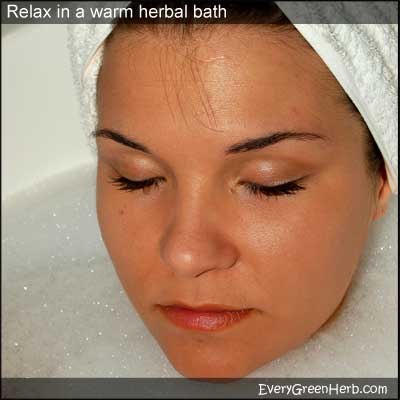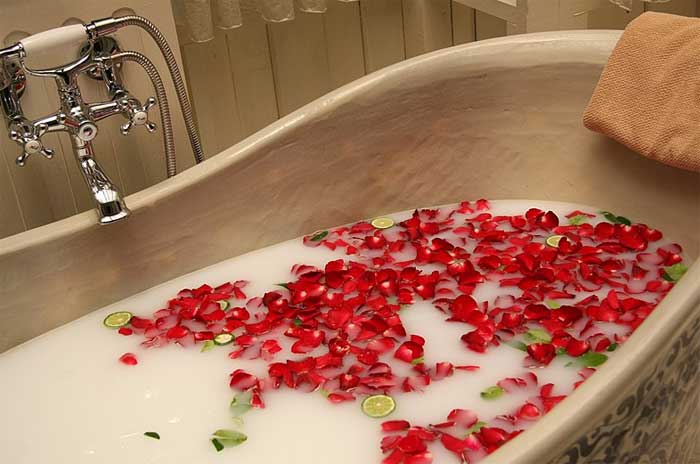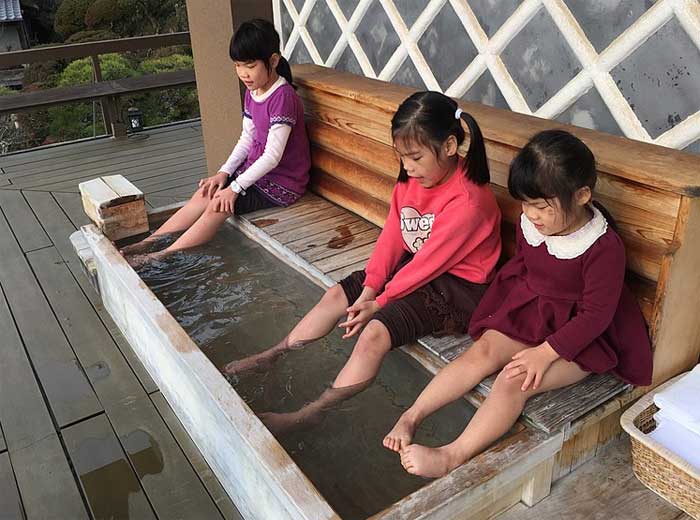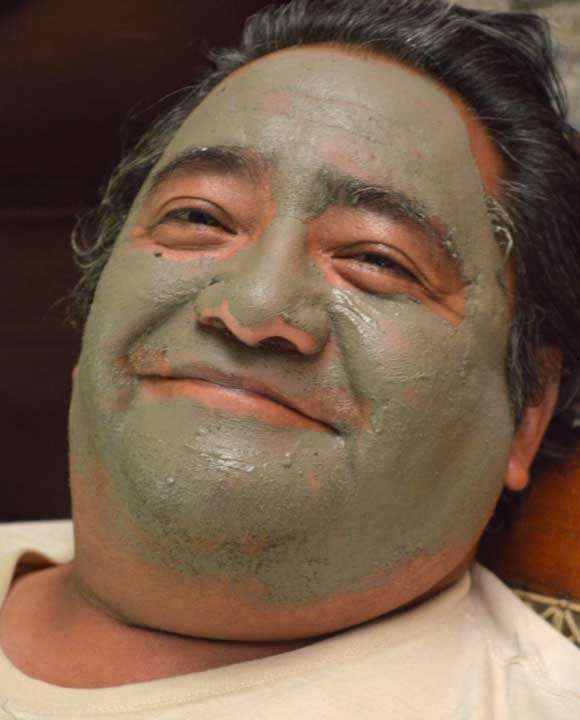Herbal baths, salts, scrubs, oils, and beauty routines

Herbal baths can relax the body, stimulate blood flow, calm the emotions, moisturize the skin, aid digestion, and heal various other complaints.
Adding herbal infusions (strong teas) and essential oils to your bath is an easy way to get the healing properties of herbal plants into your daily life.
Also add herbal salt scrubs to your beauty routine. Salt scrubs will help rejuvenate the skin. Easy to make and requiring only a few ingredients, salt scrubs remove dead skin cells, draw out toxins, make fine lines disappear, and give skin a youthful glow.
And don't forget herbal facials. They are a great home remedy for skin problems like dry skin and fine wrinkles.
Repair damaged skin with an herbal bath.
To stimulate healthy skin regeneration, add a few drops of sage essential oil, parsley essential oil, sandalwood essential oil, or thyme essential oil, along with any good-quality cold-pressed oil, to a warm bath.
These essential oils have antioxidant properties that help heal and repair the skin. They will also leave your skin moisturized and glowing.
Herbal baths can be used to stimulate the lymphatic system.
Use of herbs in the bath helps improve lymphatic drainage and blood flow. Toxins and cellular debris are more quickly cleared from the body, resulting in improved health and vitality.
Eat a diet rich in antioxidants (fresh vegetables and fruits) for best results. It is hard for herbal remedies to work if your diet is full of junk.
Unprocessed foods, whole grains, fruits, and green vegetables should be eaten several times a day.

Herbal baths can relieve pain.
For arthritis or joint soreness, use fresh sage, lavender flowers, and bay leaves (or bay essential oil) in your bath. Boil the medicinal herbs in water for a minute and then steep for fifteen minutes. Strain into your bath and try to relax while taking slow, deep breaths.
This technique is a great natural pain reliever. For added relief sip willow or oak bark tea immediately before or during a bath.
Essential oils for a relaxing bath
Relaxing herbal baths are a great sleep aid when suffering with insomnia. For a sedative effect in the bath, use essential oils. Marjoram, passion flower, sandalwood, lavender, and bergamot essential oils are good ones to try.
Chamomile essential oil is good for relaxing tired, achy muscles. Essential oils are wonderful additions to the bath and I always add a few drops to mine.
Prefer a stimulating herbal bath?
Rosemary, peppermint, and mandarin essential oil are good additions for a stimulating, uplifting bath. Invigorating baths improve the circulation and speed up digestion.
While enjoying your bath, try using a herbal salt scrub for smoothing skin. If using essential oils, use only a few drops to avoid irritation and burning sensations. Essential oils are powerful substances.

Use powdered milk for a moisturizing herbal bath.
Powdered milk may be added to the herbal bath as a moisturizer. Add two tablespoons of olive oil and a few drops of rose or jasmine essential oil for best results.
Any cold-pressed vegetable or nut oil may be used in an herbal bath. Almond oil, avocado oil, sunflower oil, safflower oil, walnut oil, and grapeseed oil are all excellent additions for moisturizing the skin.
For dry, flaky skin try scrubbing with an oatmeal sachet.
Just tie up a good portion of oatmeal in a clean handkerchief or thin cloth. Gentle rubbing with the oatmeal sachet will get rid of dead skin especially on the elbows, thighs, and hips. Exfoliation is a great way to get a younger looking complexion.
Oatmeal scrubs also also good for people with sensitive skin. Salt scrubs may be too rough, but oatmeal is gentle.
Dry skin? Try a no-salt herbal scrub.
Here's a scrub recipe that is good for dry skin. No salt is required.
- Grind 1 cup of oats into a fine powder.
- Put in a bowl and add one-fourth cup of ground poppy seeds or almonds.
- Add a cup of powdered green clay.
- Add one-fourth cup of dried herbs such as lavender, rose petals, calendula, comfrey, or chamomile, in any combination.
- Cover with oil.
- Mix well and store in a large wide-mouth jar with a tight fitting lid (keeps for up to six months in the refrigerator).
- Use a small amount of scrub on wet face with gentle circular motions. For a longer shelf life, add a few drops of tea tree oil.

Making herbal bath tea bags for gifts
If you want to make herbal bath salts for yourself, as gifts for friends, or to sell for a profit, join Katie Lane in her little purple potting shed where she shows how to make some herbal bath tea bags, the perfect homemade gift for family, friends and yourself.
Take a frankincense bath for headache relief.
For tension headache, panic attacks, or stress related problems, try adding frankincense and chamomile essential oil to the bath. Combine with olive or peach kernel oil for added benefits.
Herbal bath oil recipe
A basic bath or body oil can be made from any good cold pressed vegetable or nut oil. Pour into a jar or bottle, add a teaspoon of wheat germ oil, and add ten drops of lavender essential oil.
Use in a warm bath every day during the winter months, and use on skin to moisturize and protect.
Use herbal foot baths for insomnia.
Foot baths are used to treat everything from the flu to varicose veins. Submerge both feet in a deep enough container so that water goes up to the calves.
A cold foot bath can relieve headache and insomnia.
Alternating hot and cold water helps improve circulation. Try soaking in hot water for two minutes, then cold water for one minute. Repeat 10 times.
To treat colds and flu naturally, add strong mustard, freshly grated ginger, or horseradish to foot bath and soak twenty minutes.

Tips for making and using herbal salt scrubs
Herbal salt scrubs are easy to make at home.
- Pour sea salt or Epsom salt into an 8 oz. wide-mouth jar (or bowl) leaving 2 inches head-space.
- Pour quality vegetable or nut oil over salt until covered.
- Add 5 to 10 drops of essential oil and stir with wooden spoon.
- Use on wet skin or in the shower with a gentle circular motion. Go easy, you don't want to be left with abrasions.
- Rinse and towel dry. Follow with a good herbal moisturizer.
Herbal salt scrubs are easy to make with just a few ingredients such as Epsom salts, cold-pressed vegetable oil, and a few drops of your favorite essential oil.
Salt scrubs can be used for soaking, as well as scrubbing.
The salts and medicinal herbs will pull out toxins and greatly improve many skin problems.
You can use aromatherapy and salt scrubs at home.
Resorts and day spas offer many luxuries including soothing massages, aromatherapy baths, and salt scrubs. Tired skin is rejuvenated and busy minds are calmed during the process.
It takes a professional to do a good massage, but aromatherapy baths and herbal salt scrubs can be done at home at a fraction of the cost.
Choose your favorite essential oils.
My favorite, lavender essential oil is always a good choice for herbal baths, salt scrubs, and facials. It is not as expensive as some of the other florals.
Ylang-ylang and rose essential oils are excellent for the skin if you have them on hand or want to splurge, but they cost more.
Energizing salt scrub recipe
Uses equal measures of sea salt and Epsom salts (one cup each), almond oil to cover, 6 drops of lavender oil, 6 drops of patchouli oil, and 3 drops of orange oil. Herbal scrubs stimulate circulation and remove dead skin cells. They leave the skin glowing and soft.
Ginger salt scrub for feet and elbows
A mix of ordinary cooking ingredients can produce a wonderful scrub. Add a quarter cup of powdered ginger root, one-half cup of ordinary table salt, and the juice of two limes to one-half cup of warm olive oil.
Use this gritty paste to exfoliate feet, elbows, and other rough places. The ginger root will leave skin tingling and smooth.
Choose essential oils based on skin type
The choice of essential oils in a scrub should be based on skin type.
Chamomile, lavender, carrot seed, and ylang-ylang essential oils are good for moisturizing fine wrinkles.
Dry skin can benefit from geranium, frankincense, lavender, and sandalwood.
Teenage acne calls for lemon grass, lavender, lemon thyme, tea tree, or sage.
Sensitive skin will soak up chamomile or rose oil without causing any irritation.
Essential oils come in many unique scents.
Essential oils have a vast array of scents ranging from intensely floral to sharply antiseptic. Rose, ylang-ylang, jasmine, gardenia, and neroli essential oils have the intoxicating fragrance of exotic flowers.
Rosemary, tea tree, eucalyptus, and sage essential oils have a clean, medicinal scent. If possible, experiment with individual oils before using blends.
Each person's system is unique and reactions to different oils can be surprising.
Use common sense when using herbal remedies.
If you are attracted to an essential oil or individual herb then use more of it. If you are repulsed by something, discontinue use.
Do not overuse essential oils. A few drops go a long way. Always dilute essential oils before applying to skin. Do not take them internally unless directed to do so by your healthcare professional.

Herbal facials
Herbal facials and cleansing masks are also easy to make at home. For beautiful skin, try a cleansing and moisturizing facial.
Many things can be added to facials including vegetable oils, green clay, honey, essential oils, aloe vera, oats, eggs, raw vegetables, cider vinegar, and fruit pulp.
To deep cleanse, use a green clay mask followed by an oil facial. Add geranium essential oil for normal skin, rose oil for dry skin, jojoba oil for oily skin, avocado oil for sensitive skin, and frankincense essential oil for mature skin.
Good carrier oils include apricot kernel, almond, hazelnut, walnut, jojoba, olive, flaxseed, grape seed, and safflower. Always dilute essential oils before applying to skin.
Favorite facial oils
For all skin types, combine a tablespoon of jojoba oil, two drops of geranium, a drop of frankincense, and a drop of myrrh essential oil.
A good facial oil for normal to oily skin combines a tablespoon of jojoba oil, three drops of lavender, and three drops of ylang-ylang essential oil.
Apply before bedtime with fingertips, using gentle circular motions.

Using a pore strip before a regular cleansing can help eliminate black-heads.
Facial cleansing with herbs
To deep cleanse the face after normal washing, prepare a herbal steam facial.
- Add three drops of eucalyptus essential oil and three drops of lavender essential oil to a pot of boiling water that has been removed from its heat source.
- Drape a towel over head and lean over pot.
- Do not get so close that face is burned. About twelve to eighteen inches is safe. Always use common sense when in the kitchen!
- Stay under the towel for five or six minutes with eyes closed. Pat dry.
Fresh and dried herbs may also be used in a steam facial. Try chamomile, rose, comfrey, lavender, sage, rosemary, or calendula.
Steam the face for five to eight minutes. Rinse with cold water and follow with a good moisturizing herbal cream or oil.
Herbal steam facials are best when done on a weekly basis.
Herbal baths are nothing new.
Ancient Greeks believed that natural springs were blessed by the gods, causing diseases to be healed.
Herbal baths have been popular around the world for centuries. People have used them for cleansing, healing, and purification.
Sometimes herbal baths are taken alone, but at other times whole villages participate.
Newborns are bathed in herbs to improve their strength. It is also believed that herbal baths will cause babies to walk sooner, but scientific evidence is sketchy.
Women in some cultures take herbal baths to tighten the vagina and increase sexual pleasure.
In the Maroon culture of Brazil, when modern medicine doesn't work, people turn to herbal baths to ward off malicious spirits. They also take herbal baths for skin disorders and respiratory problems.
With the Amazon rainforest in their backyard, many of the plants they use in herbal baths are unknown to the western world.
More herbal bath history
Chinese cultures have used herbal baths for thousands of years.
Herbal baths are often recommend for the treatment of insomnia. During a herb bath, plant properties are absorbed through the skin to act upon meridians and acupoints.
Herbal baths are widely used in China as a low cost and convenient treatment of insomnia. Plus, there are no side effects!
*Always use common sense when preparing herbal beauty products for home use. Wash off immediately, and discontinue use if burning or irritation develops. Some herbs and essential oils should not be used before sun exposure.
Sources:
https://www.ncbi.nlm.nih.gov/pmc/articles/PMC5856216/
https://www.ncbi.nlm.nih.gov/pmc/articles/PMC7373592/
Blessings to you and yours!
Thanks so much for reading my blog. Jan.

*Note - the information on this website has not been evaluated by the Food and Drug Administration.
© 2005-2024 website design and content by Janice Boling